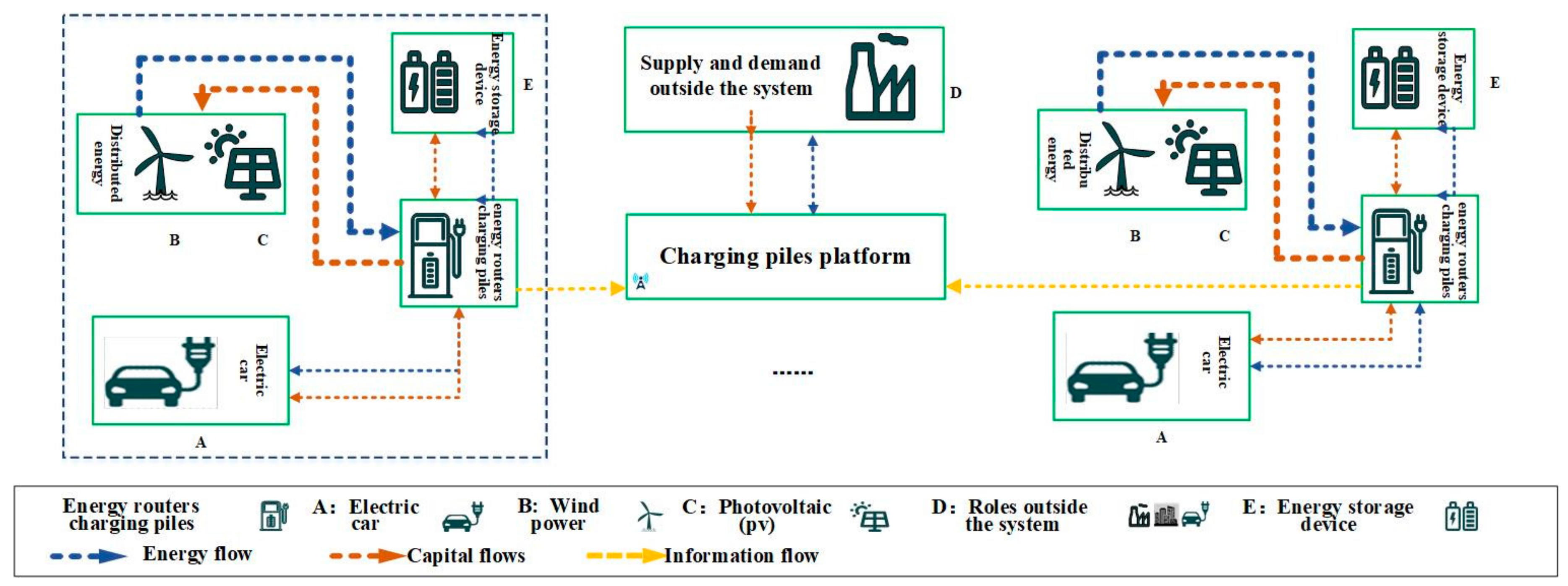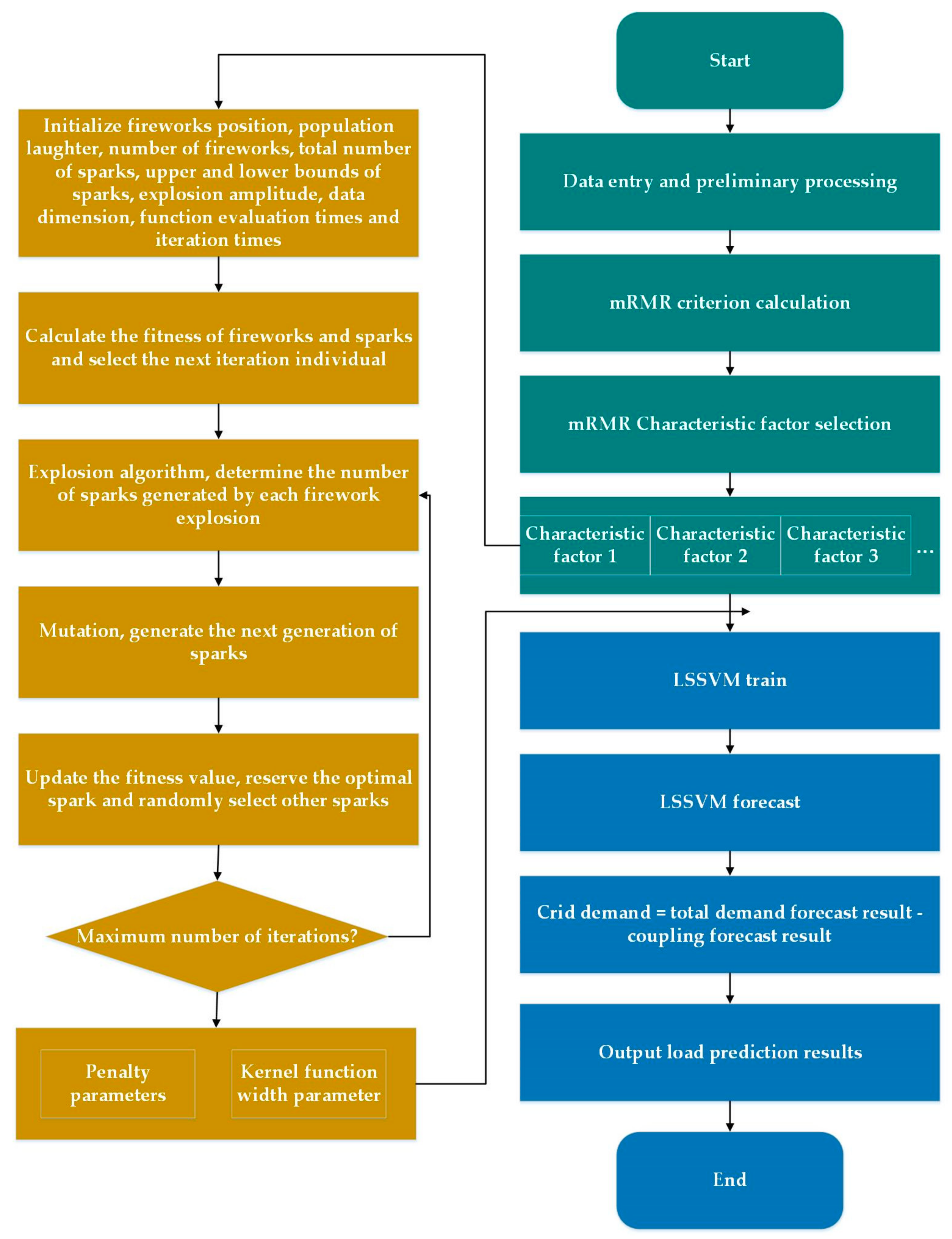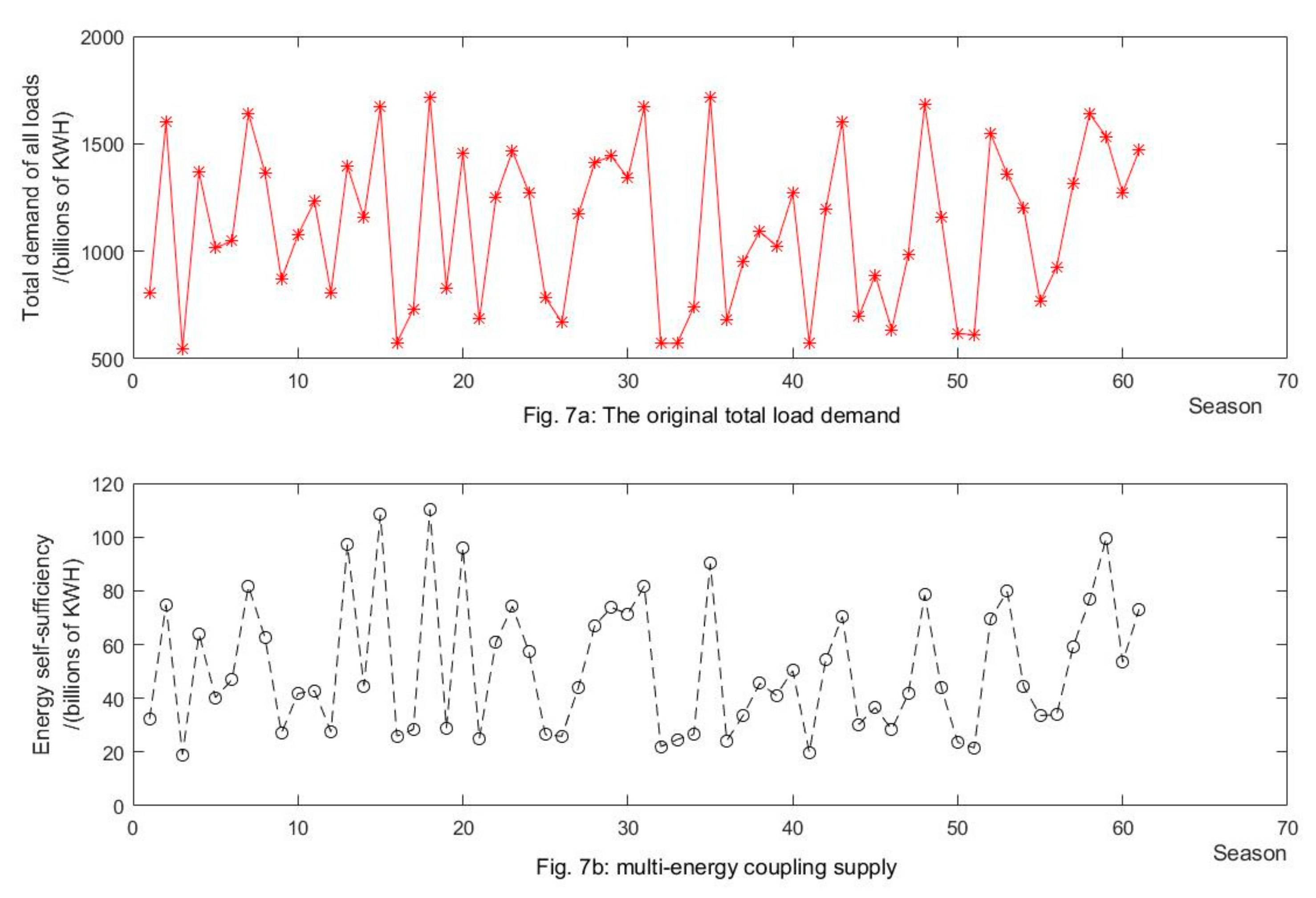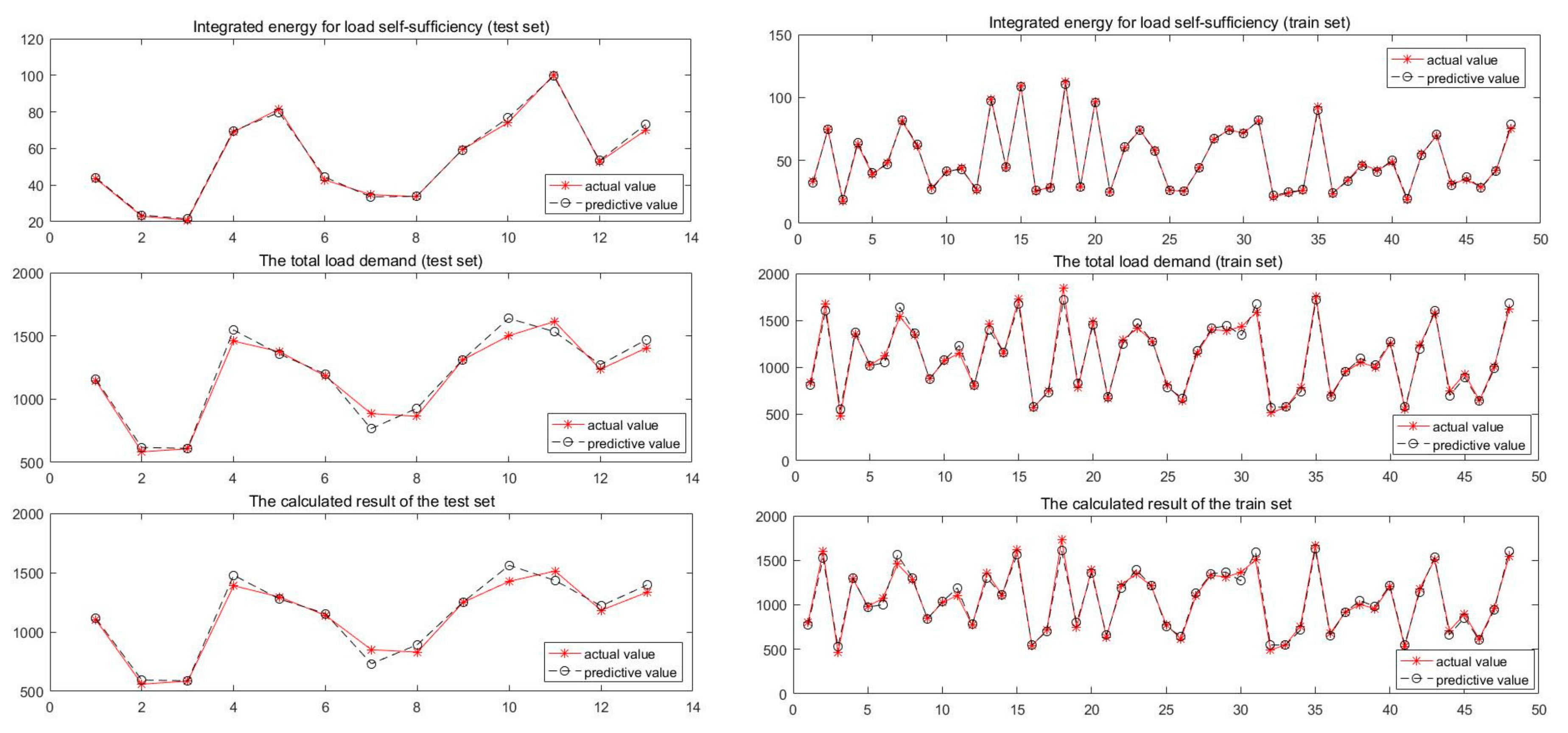Power Load Demand Forecasting Model and Method Based on Multi-Energy Coupling
Abstract
1. Introduction
2. Power Load Demand Analysis
2.1. Calculation of Power Load Demand
2.2. Multi-Energy Coupling Analysis
2.2.1. Subject Analysis
2.2.2. Multi-Energy Coupling of Typical Scenarios
- Coupling utilization of renewable energy
- Energy conservation in energy-intensive enterprises
- Digital platform
2.2.3. Coupling Supply-Demand Mechanism Analysis
2.3. Key Influencing Factors
3. Model Construction
3.1. Feature Selection Based on Minimal Redundancy Maximal Relevance (mRMR)
3.1.1. MI Calculation
3.1.2. Maximal Relevance
3.1.3. Minimum Redundancy
3.1.4. mRMR Criteria
3.2. Adaptive Fireworks Algorithm (AFWA)
3.2.1. FWA
- Initialize data
- Explosion operator.
- Mutation operator
- Mapping rules
- Select operation
3.2.2. Adaptive Adjustment
3.3. Least Squares Support Vector Machine (LSSVM)
3.4. mRMR-AFWA-LSSVM Model
- Analyzing the possible influencing factors according to the system structure of the multi-energy scenario, collecting the corresponding data content, and conducting preliminary processing of the data. The operation here is mainly data normalization, and the dimensionless data retains the internal meaning while facilitating the calculation of the model.
- The mRMR feature factor selection process, which selects the key influencing factors at the top of the score, and they have the maximum load forecasting correlation and minimum information redundancy.
- Optimizing its width coefficient and penalty parameters by embedding AFWA into the LSSVM model.
- The training and forecasting process of LSSVM, through which the quarterly forecasting quantity of total load demand and multi-energy coupling energy supply can be obtained respectively, and the predicted value of load needed to be provided with the grid can be obtained by making the difference between them.
4. Case Analysis
4.1. mRMR Key Factor Analysis
4.2. Load Forecasting With AFWA-SVM
4.3. Comparative Analysis and Conclusions
- In terms of forecasting accuracy, AFWA effectively improved the forecasting accuracy of the LSSVM model, increasing the multi-energy coupling supply forecast by about 5% and the total load forecast by about 2%. In fact, the application of LSSVM significantly improved the prediction accuracy in our experiment compared with the SVM model, which the multi-energy coupling supply forecast increased by about 6%, and the total load forecast increased by about 4%. Compared with the PSO-LSSVM model, the AFWA-LSSVM model had a certain degree of efficiency improvement, with the multi-energy coupling supply forecast increasing by about 0.4% and the total load forecast increasing by about 0.3%.
- In terms of computing efficiency, the application of mRMR significantly sped up the computing speed of the model, and could assist scene analysis to a certain extent. Those with structural connections or similar key nodes tended to have a large degree of redundancy, while those with weak correlation had a small degree of correlation.
- At the same time, aiming at the optimization problem of future application of the model, we could start from digging into the key influencing factors of demand prediction. The accuracy of multi-energy coupling forecasting was better than that of total load forecasting, its better indicator system was partly to blame.
- It could be found from the analysis that the total load demand was the most important factor affecting the power network load supply, and also the main source of errors. The appropriate influence factor selection and feature analysis would improve the accuracy of forecasting mode.
5. Discussion
- The power grid needs to meet the needs of power users, which will be impacted by the multi-energy coupling energy supply. The difference between the total load demand and the multi-energy coupling energy supply is the power the grid needs to provide.
- As the characteristics and energy flow of different multi-energy coupling scenarios were in great difference, we had to conclude the series of key influencing factors that affect the total load demand and multi-energy coupling supply from the energy flow of multi-energy scenarios.
- The minimal redundancy maximal relevance algorithm was applied to select the top-n critical influencing factors from the series of key influencing factors, which effectively improved the stability, accuracy, and calculation speed of the model.
- The least squares support vector machine model optimized by adaptive fireworks algorithm was used for prediction, which was more accurate than other algorithms.
Author Contributions
Funding
Conflicts of Interest
References
- Wang, Y.; Wang, X.; Yu, H.; Huang, Y.; Dong, H.; Qi, C.; Baptiste, N. Optimal design of integrated energy system considering economics, autonomy and carbon emissions. J. Clean. Prod. 2019, 225, 563–578. [Google Scholar] [CrossRef]
- Yuping, Z.; Dan, W.; Can, W.; Zhihong, Y.; Jinru, L. Key Technologies and Applications of Energy Internet for New Towns. Autom. Electr. Power Syst. 2019, 43, 1–14. [Google Scholar]
- Liang, X. Emerging Power Quality Challenges Due to Integration of Renewable Energy Sources. IEEE Trans. Ind. Appl. 2017, 53, 855–866. [Google Scholar] [CrossRef]
- Yong, L.; Zhenyu, S.; Yu, W. Monthly Load Forecasting Model Based on Seasonal Adjustment and BP Neural Network. Syst. Eng. Theory Pract. 2018, 38, 1052–1060. [Google Scholar]
- Lifan, M.; Jiangang, Y.; Yongshun, J.; Huanlin, C.; Wenjie, L.; Shilei, G. Theoretical Study of Combination Model for Medium and Long Term Load Forecasting. Proc. CSEE 2010, 30, 53–59. [Google Scholar]
- Research Review on Charge and Discharge Load Prediction of Electric Vehicles. Autom. Electr. Power Syst. 2019, 43, 177–197.
- Li, L.L.; Wen, S.Y.; Tseng, M.L.; Wang, C.S. Renewable energy prediction: A novel short-term prediction model of photovoltaic output power. J. Clean. Prod. 2019, 228, 359–375. [Google Scholar] [CrossRef]
- Li, Z.; Xu, Y. Temporally-coordinated optimal operation of a multi-energy microgrid under diverse uncertainties. Appl. Energy 2019, 240, 719–729. [Google Scholar] [CrossRef]
- Li, B.; Roche, R.; Paire, D.; Miraoui, A. Sizing of a stand-alone microgrid considering electric power, cooling/heating, hydrogen loads and hydrogen storage degradation. Appl. Energy 2017, 205, 1244–1259. [Google Scholar] [CrossRef]
- Balaji, V.; Gurgenci, H. Search for optimum renewable mix for Australian off-grid power generation. Energy 2019, 175, 1234–1245. [Google Scholar] [CrossRef]
- Hong, B.; Zhang, W.; Zhou, Y.; Chen, J.; Xiang, Y.; Mu, Y. Energy-Internet-oriented microgrid energy management system architecture and its application in China. Appl. Energy 2018, 228, 2153–2164. [Google Scholar] [CrossRef]
- Kim, E.-J.; He, X.; Roux, J.-J.; Johannes, K.; Kuznik, F. Fast and accurate district heating and cooling energy demand and load calculations using reduced-order modelling. Appl. Energy 2019, 238, 963–971. [Google Scholar] [CrossRef]
- Ehsan, A.; Yang, Q. Scenario-based investment planning of isolated multi-energy microgrids considering electricity, heating and cooling demand. Appl. Energy 2019, 235, 1277–1288. [Google Scholar] [CrossRef]
- Wang, X.; Chang, J.; Meng, X.; Wang, Y. Short-term hydro-thermal-wind-photovoltaic complementary operation of interconnected power systems. Appl. Energy 2018, 229, 945–962. [Google Scholar] [CrossRef]
- Wang, D.; Hu, Q.E.; Jia, H.; Hou, K.; Du, W.; Chen, N.; Fan, M. Integrated demand response in district electricity-heating network considering double auction retail energy market based on demand-side energy stations. Appl. Energy 2019, 248, 656–678. [Google Scholar] [CrossRef]
- Liang, Y.; Niu, D.; Hong, W.C. Short term load forecasting based on feature extraction and improved general regression neural network model. Energy 2019, 166, 653–663. [Google Scholar] [CrossRef]
- Wang, J.; Hu, J. A robust combination approach for short-term wind speed forecasting and analysis—Combination of the ARIMA (Autoregressive Integrated Moving Average), ELM (Extreme Learning Machine), SVM (Support Vector Machine) and LSSVM (Least Square SVM) forecasts using a GPR (Gaussian Process Regression) model. Energy 2015, 93, 41–56. [Google Scholar] [CrossRef]
- Nantian, H.; Bin, Q.; Zuoming, L.; Guowei, C.; Enkai, X. Gaussian Process Regression Probability Short-Term Load Prediction Based on Area Grey Correlation Decision Making. Autom. Electr. Power Syst. 2018, 42, 64–75. [Google Scholar]
- He, Y.; Zhang, Y.; Yang, S. Medium and Long Term Probability Density Forecasting Based on Box-Cox Transformation Quantile Regression and Load Relation Factor Identification. Syst. Eng. Theory Pract. 2018, 38, 197–207. [Google Scholar]
- Liu, J.; Zhao, H.; Liu, J.; Pan, L.; Wang, K. Mid-term Load Prediction Based on Cointegration-Granger Causality Test and Seasonal Decomposition. Autom. Electr. Power Syst. 2019, 43, 73–80. [Google Scholar] [CrossRef]
- Xu, N.; Ding, S.; Gong, Y.; Bai, J. Forecasting Chinese greenhouse gas emissions from energy consumption using a novel grey rolling model. Energy 2019, 175, 218–227. [Google Scholar] [CrossRef]
- Sadaei, H.J.; de Lima e Silva, P.C.; Guimarães, F.G.; Lee, M.H. Short-term load forecasting by using a combined method of convolutional neural networks and fuzzy time series. Energy 2019, 175, 365–377. [Google Scholar] [CrossRef]
- Kong, X.; Li, C.; Zheng, F.; Yu, L.; Ma, X. Short-term load forecasting method based on empirical modal decomposition and characteristic correlation analysis. Autom. Electr. Power Syst. 2019, 43, 46–56. [Google Scholar]
- Meng, M.; Shang, W.; Zhao, X.; Niu, D.; Li, W. Decomposition and forecasting analysis of China’s energy efficiency: An application of three-dimensional decomposition and small-sample hybrid models. Energy 2015, 89, 283–293. [Google Scholar] [CrossRef]
- Dai, S.; Niu, D.; Li, Y. Forecasting of Energy Consumption in China Based on Ensemble Empirical Mode Decomposition and Least Squares Support Vector Machine Optimized by Improved Shuffled Frog Leaping Algorithm. Appl. Sci. 2018, 8, 678. [Google Scholar] [CrossRef]
- Lu, J.; Zhang, Q.; Yang, Z.; Tu, M.; Lu, J.; Peng, H. Short-Term Load Forecasting Method Based on CNN-LSTM Hybrid Neural Network Model. Autom. Electr. Power Syst. 2019, 43, 131–137. [Google Scholar]
- Chang, C.C.; Lin, C.J. Libsvm: A library for support vector machines. ACM Trans. Intell. Syst. Technol. 2011, 2, 1–27. [Google Scholar] [CrossRef]
- Li, C.; Li, S.; Liu, Y. A least squares support vector machine model optimized by moth-flame optimization algorithm for annual power load forecasting. Appl. Intell. 2016, 45, 1166–1178. [Google Scholar] [CrossRef]
- Chen, T.T.; Lee, S.J. A weighted LS-SVM based learning system for time series forecasting. Inf. Sci. 2015, 299, 99–116. [Google Scholar] [CrossRef]
- Chen, Y.; Yang, Y.; Liu, C.; Li, C.; Li, L. A hybrid application algorithm based on the support vector machine and artificial intelligence: An example of electric load forecasting. Appl. Math. Model. 2015, 39, 2617–2632. [Google Scholar] [CrossRef]
- Bedi, J.; Toshniwal, D. Deep learning framework to forecast electricity demand. Appl. Energy 2019, 238, 1312–1326. [Google Scholar] [CrossRef]
- Ying, T. Introduction to Fireworks Algorithm; Science Press: Beijing, China, 2013. [Google Scholar]
- Li, J.; Zheng, S.; Tan, Y. Adaptive Fireworks Algorithm. In Proceedings of the 2014 IEEE Congress on Evolutionary Computation (CEC), Beijing, China, 6–11 July 2014; pp. 3214–3221. [Google Scholar]
- North Star Power Network News Center. The “863” National “Luxi Island” Micro-Grid Demonstration Project Was Put into Operation [EB/OL]; North Star Power Network News Center: Beijing, China, 2014; Available online: http://news.bjx.com.cn/html/20140126/489014.shtml (accessed on 26 January 2014).
- Zhang, Y.; Jiang, B.; Diao, X.; Li, T.; Zhang, J.; Liu, Y.; Xu, Q. Distributed Energy Trading System Based on Internet of Vehicles Platform. Power Constr. 2019, 40, 10–17. [Google Scholar]
- Barman, M.; Dev Choudhury, N.B.; Sutradhar, S. A regional hybrid GOA-SVM model based on similar day approach for short-term load forecasting in Assam, India. Energy 2018, 145, 710–720. [Google Scholar] [CrossRef]
- Chapaloglou, S.; Nesiadis, A.; Iliadis, P.; Atsonios, K.; Nikolopoulos, N.; Grammelis, P.; Kakaras, E. Smart energy management algorithm for load smoothing and peak shaving based on load forecasting of an island’s power system. Appl. Energy 2019, 238, 627–642. [Google Scholar] [CrossRef]
- Tan, Y.; Zhu, Y. Fireworks Algorithm for Optimization. In Advances in Smart Intelligence; Springer: New York, NY, USA, 2010. [Google Scholar]
- Wang, W.; Men, C. Support Vector Machine Modeling and Application; Science Press: Beijing, China, 2014. [Google Scholar]









| No. | Reference | Forecast Scenario | Forecast Model | Scope of Application |
|---|---|---|---|---|
| 1 | [16] | Electricity market transaction | EMD-mRMR-FOA-GRNN | Short-term load forecasting (STLF) |
| 2 | [17] | Wind power generation | ELM, SVM, and LSSVM | Short-term wind power forecast |
| 3 | [18] | Electricity market transaction | Gaussian process regression | STLF |
| 4 | [19] | Regional power planning | Box-cox transformation quantile regression and load relation factor identification | Medium and long term load forecasting and load probability density forecasting |
| 5 | [20] | ---- | SVM forecasting based on cointegration—granger causality test and seasonal decomposition | Monthly load forecast |
| 6 | [21] | Greenhouse gas emissions | Adaptive grey model | Annual greenhouse gas emissions |
| 7 | [22] | ---- | A combined method that is based on the fuzzy time series (FTS) and convolutional neural networks (CNN) | STLF |
| 8 | [23] | Generation planning and scheduling | EMD-mRMR-PSO (particle swarm optimization)-LSSVM | STLF |
| 9 | [24] | China’s energy efficiency | Three-dimensional decomposition model and small-sample hybrid model | Annual energy efficiency forecast |
| 10 | [25] | Energy consumption | EEMD-ISFLA (Shuffled Frog Leaping Algorithm)-LSSVM | Annual energy consumption forecast |
| 11 | [26] | Electric power dispatching | CNN-LSTM (long short term memory) | STLF |
| 12 | [27] | Algorithm | SVM | Classification and forecasting problems |
| 13 | [28] | Power planning, operation and maintenance | MFO (Moth-Flame Optimization algorithm) -LSSVM | Annual load forecast |
| 14 | [29] | Electricity market trading and electricity distribution plan | Empirical mode decomposition, seasonal adjustment, PSO, and LSSVM model | STLF |
| 15 | [30] | Power assisted decision making | Weighted LSSVM based approach for time series forecasting | Annual load forecast |
| 16 | [31] | Demand for electricity | Deep learning framework | Seasonal and diurnal power demand forecasting |
| Multi-Energy on the Supply Side | Multi-Energy on the Demand Side | Interactive Coupling Mode of Supply and Demand | |
|---|---|---|---|
| Subject | All kinds of renewable energy power generation manufacturers, cogeneration, energy storage, triple supply manufacturers, etc. | Commerce, industry, agriculture, government, public utilities, etc. | All kinds of energy suppliers, all kinds of energy users, Internet of vehicles, virtual power plants, etc. |
| Coupling design rationale | Spatial and temporal differences of different primary energy sources | Different loads vary in time, flexibility, and economic requirements | Spatio-temporal difference, information interaction, economy, and benefit difference between supply and demand |
| Typical coupling mode | Multi-energy coupling power generation | Multistage utilization of energy | Interaction of supply and demand |
| The coupling efficiency | Energy self-sufficiency | Energy saving | Reduce dispatch difficulty and improve economic benefit |
| The Key Content | Decomposition of Content | Impact Factor |
|---|---|---|
| Total demand of all loads | Economic development | GDP current value |
| Price index | ||
| Industrial structure | Contribution rate of primary industry | |
| Contribution rate of secondary industry | ||
| Quarterly contribution rate of tertiary industry | ||
| Coupling efficiency | Total fixed asset investment | |
| Energy self-sufficiency | Renewable energy generation | Wind power generation |
| Solar power generation | ||
| Hydropower generation | ||
| Other renewable energy power generation | ||
| Gas turbine installations, | Natural gas production | |
| Other energy | - | |
| Energy economy | Fuel price index | |
| Investment |
| Characteristic Factor | Solar Power Generation (10 Million KWH) | Natural Gas Production (100 Million Cubic Meters) | Wind Power Generation (Billions of KWH) | Hydropower Generation (Billions of KWH) | Other Renewable Energy Power Generation (Billions of KWH) | Investment ($10 Thousand) | Fuel Price Index |
|---|---|---|---|---|---|---|---|
| MRMR criterion | 0 | −0.16 | 1.63 | 0.94 | 0.52 | 0.62 | 0.60 |
| Rank | 6 | 7 | 1 | 2 | 5 | 3 | 4 |
| Characteristic Factor | Contribution Rate of Primary Industry (%) | Contribution Rate of Secondary Industry (%) | Quarterly Contribution Rate of Tertiary Industry (%) | Total Fixed Asset Investment (100 Million Yuan) | GDP Current Value ($100 Million) | Price Index |
|---|---|---|---|---|---|---|
| mRMR criterion | 0 | −0.066 | 0.73 | 0.96 | 0.94 | 1.30 |
| Rank | 5 | 6 | 4 | 2 | 3 | 1 |
| The Parameter Name | Values |
|---|---|
| The population size | 5 |
| The number of fireworks in gauss explosions | 5 |
| The total number of sparks | 200 |
| Spark upper bound parameter | 100 |
| Spark lower bound parameter | 0.1 |
| Blast amplitude control parameters | 100 |
| Data dimension | 2 |
| Function evaluation number | 1 |
| The number of iterations | 1 |
| Penalty Parameters (c) | Width Parameter of Kernel Function (g) | |
|---|---|---|
| Multi-energy coupled forecasting | 30.9715 | 60.4294 |
| Total load forecasting | 26.4350 | 61.0462 |
| Actual | mRMR-AFWA-LAAVM | AFWA-LSSVM | LSSVM | AFWA-SVM | ||||||||||
|---|---|---|---|---|---|---|---|---|---|---|---|---|---|---|
| Integrated Energy | Total Load | Load | Integrated Energy | Total Load | Load | Integrated Energy | TOTAL LOAD | Load | Integrated Energy | Total Load | Load | Integrated Energy | Total Load | Load |
| 43.53 | 1144.58 | 1101.05 | 44.01 | 1157.58 | 1113.57 | 43.57 | 1160.97 | 1117.41 | 43.10 | 1121.60 | 1078.50 | 46.09 | 1183.59 | 1137.50 |
| 23.02 | 583.70 | 560.68 | 23.63 | 618.07 | 594.44 | 23.59 | 619.31 | 595.72 | 25.10 | 692.72 | 667.62 | 26.33 | 620.27 | 593.93 |
| 20.87 | 606.83 | 585.96 | 21.49 | 610.35 | 588.86 | 21.86 | 607.40 | 585.54 | 24.07 | 738.53 | 714.47 | 24.83 | 631.58 | 606.75 |
| 68.93 | 1458.72 | 1389.79 | 69.64 | 1547.29 | 1477.65 | 70.62 | 1551.04 | 1480.42 | 72.72 | 1514.04 | 1441.32 | 70.83 | 1598.52 | 1527.69 |
| 81.54 | 1376.27 | 1294.73 | 79.71 | 1357.01 | 1277.30 | 78.75 | 1363.14 | 1284.39 | 69.52 | 1311.22 | 1241.70 | 78.68 | 1386.29 | 1307.60 |
| 42.79 | 1182.28 | 1139.49 | 44.34 | 1199.14 | 1154.80 | 43.86 | 1193.60 | 1149.74 | 45.17 | 1229.65 | 1184.48 | 47.09 | 1251.71 | 1204.61 |
| 34.81 | 885.21 | 850.40 | 33.62 | 765.90 | 732.28 | 33.18 | 767.00 | 733.83 | 34.43 | 811.78 | 777.35 | 36.28 | 740.13 | 703.85 |
| 33.71 | 864.45 | 830.74 | 33.82 | 927.19 | 893.37 | 34.55 | 929.36 | 894.81 | 37.95 | 939.57 | 901.62 | 37.67 | 895.39 | 857.72 |
| 59.35 | 1310.27 | 1250.92 | 59.26 | 1312.34 | 1253.08 | 59.82 | 1306.28 | 1246.46 | 61.08 | 1378.42 | 1317.34 | 62.48 | 1383.28 | 1320.79 |
| 74.12 | 1501.11 | 1426.99 | 76.71 | 1638.69 | 1561.98 | 77.44 | 1629.99 | 1552.55 | 81.30 | 1563.00 | 1481.70 | 78.64 | 1653.84 | 1575.20 |
| 100.27 | 1613.74 | 1513.47 | 99.54 | 1533.31 | 1433.77 | 98.85 | 1528.14 | 1429.29 | 89.01 | 1515.98 | 1426.98 | 96.34 | 1530.60 | 1434.26 |
| 52.79 | 1235.36 | 1182.57 | 53.38 | 1272.74 | 1219.35 | 53.66 | 1277.24 | 1223.58 | 54.05 | 1218.30 | 1164.25 | 56.57 | 1268.14 | 1211.57 |
| 69.93 | 1404.35 | 1334.42 | 73.15 | 1469.58 | 1396.43 | 72.84 | 1464.88 | 1392.04 | 75.90 | 1492.46 | 1416.55 | 74.69 | 1495.42 | 1420.73 |
| Time(s) | MSE | RMSE | MAE | MAPE% | R2 | ||
|---|---|---|---|---|---|---|---|
| Multi-energy coupling | mRMR-AFWA-LSSVM | 111.3100 | 2.050467 | 1.431945 | 1.103184 | 2.080982 | 0.996127 |
| AFWA-LSSVM | 145.9760 | 0.661562 | 0.813365 | 0.711322 | 2.013296 | 0.997686 | |
| LSSVM | 10.5528 | 31.99167 | 5.656118 | 4.30042 | 7.468827 | 0.939572 | |
| AFWA-SVM | 10.6015 | 12.61361 | 3.551565 | 3.418807 | 7.076095 | 0.976175 | |
| Total demand | mRMR-AFWA-LSSVM | 140.9960 | 4545.266 | 67.41859 | 52.3335 | 4.56392 | 0.956144 |
| AFWA-LSSVM | 151.3300 | 4455.127 | 66.74674 | 51.79472 | 4.518415 | 0.957014 | |
| LSSVM | 8.9416 | 5877.982 | 76.668 | 70.22673 | 6.752522 | 0.943286 | |
| AFWA-SVM | 17.5940 | 7298.541 | 85.4315 | 71.40998 | 6.138677 | 0.929579 |
© 2020 by the authors. Licensee MDPI, Basel, Switzerland. This article is an open access article distributed under the terms and conditions of the Creative Commons Attribution (CC BY) license (http://creativecommons.org/licenses/by/4.0/).
Share and Cite
Liu, D.; Wang, L.; Qin, G.; Liu, M. Power Load Demand Forecasting Model and Method Based on Multi-Energy Coupling. Appl. Sci. 2020, 10, 584. https://doi.org/10.3390/app10020584
Liu D, Wang L, Qin G, Liu M. Power Load Demand Forecasting Model and Method Based on Multi-Energy Coupling. Applied Sciences. 2020; 10(2):584. https://doi.org/10.3390/app10020584
Chicago/Turabian StyleLiu, Dunnan, Lingxiang Wang, Guangyu Qin, and Mingguang Liu. 2020. "Power Load Demand Forecasting Model and Method Based on Multi-Energy Coupling" Applied Sciences 10, no. 2: 584. https://doi.org/10.3390/app10020584
APA StyleLiu, D., Wang, L., Qin, G., & Liu, M. (2020). Power Load Demand Forecasting Model and Method Based on Multi-Energy Coupling. Applied Sciences, 10(2), 584. https://doi.org/10.3390/app10020584






